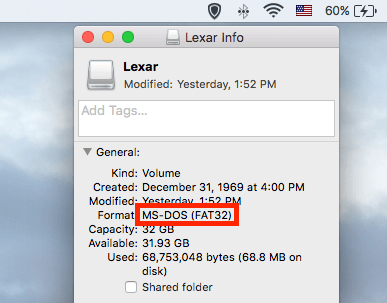

- FORMAT FAT32 ON MAC HIGH SIERRA HOW TO
- FORMAT FAT32 ON MAC HIGH SIERRA FOR MAC
- FORMAT FAT32 ON MAC HIGH SIERRA MAC OS
- FORMAT FAT32 ON MAC HIGH SIERRA UPDATE
I would like to know regarding format on my secondary harddrive on my macbook pro.At this moment my main ssd drive is on APFS format & my secondary drive im using 2TB Seagate Firecuda SSHD…should i format the SSHD into APFS too like my main ssd drive or just leave it as it is Mac Os Journaled?ĮtreCheck version: 3.4.5 (455) Report generated 18:12:32 Download EtreCheck from Runtime: 2:06 Performance: ExcellentĬlick the links for more information from Apple Support Communities.
FORMAT FAT32 ON MAC HIGH SIERRA UPDATE
If you have a tray-loading optical drive, gently push the tray closed after inserting the CD.ĥ You will hear a long tone, which indicates that the restoration process has started.ĦĚfter a short delay, you’ll see a progress bar.ħĝo not interrupt the process, disconnect power, use the mouse or keyboard, or shut down or restart your Mac during the restoration process.Ĩ When the update is complete, your Mac will automatically restart.
FORMAT FAT32 ON MAC HIGH SIERRA FOR MAC
However it brought up a good point for Mac Pro 2010-2012 users.ĭo a simple search for Firmware Restoration.īefore you attempt to install High Sierra you should create a Firmware Restoration CD.Ģ Press and hold the power on button your Mac until either the sleep light blinks three times fast, then three times slow, then three time fast (for Macs with sleep lights), or you hear three rapid tones, then three slow tones, then three rapid tones (for Macs without a sleep light).ģ Still holding the power button, insert the Firmware Restoration CD into your Mac’s optical drive. Also, drive firmware cannot be modified or changed on the fly, it cannot only be changed with special tools independent of the OS. Without specifics when you write a technique for installation that works better, the readers have to guess what you really did to fix your issue. It is always best to format and clean install with any operating system. The firmware in you drive was not modified by the OS it came modified. Unless Apple makes APFS fully compatible with all SSDs not just the shipping machine’s SSD’s which the public cannot buy as a replacements, using a 3rd party SSD as a replacement, other than a Aura Pro X, will yield possible drive issues with APFS currently. It is proving impossible to re-install SL to either Mac.Īll Apple drives (which are not manufactured by them in house, have drive firmware which has been modified by this manufacturer to Apple’s specs, this is why they are recognized as a Apple drive by the OS, vs an off the shelf SSD, which is not), come with firmware that is modified at manufacture.Īpple has acquired Toshiba so future drives may all be be made in house, or so to speak. Here in the future I have the suspicion that AAPL have burnt new firmware to both these precious support Macs.
FORMAT FAT32 ON MAC HIGH SIERRA HOW TO
After going to much trouble to ensure I had machines that could fall-back to Snow Leopard, (my ‘Sys16′ in a series of OSs from System/Finder 0.9! there is a good logic to the number, and make it *far easier to remember all the foibles and consequences of Mac) I have no idea how to rescue and reactivate my early data. I won’t say it’s the worst, but from testing a Sys24, macOS 10.14 on APFS external SSD hanging off my venerable iMac from 2009, purchase retrospectively to have a machine that was able to boot 10.6.3 it’s probably the first to slam the took shut AND MAKE USELESS any Mac that WAS able to boot into 10.6.3+ or 10.6.5+. I now havem from the future (it’s 2021 in this comment) some grasp of the consequences of this 7th, or is it eighth total rehash since my Mac 128.

Here is the rest of the technical note verbatim, with our translation of Apple’s writing in italics: Those Macs that use Fusion Drives (like the iMac, for example) or good old hard disk drives will not be converted, period. So basically, if you install APFS on any Mac that uses a solid-state drive as a built-in boot drive, it will automatically convert to APFS and you will not have a choice. You can’t opt out of the transition to APFS. (Rocket Yard emphasis) Fusion Drives and hard disk drives (HDDs) aren’t converted.

When you install macOS High Sierra on the built-in solid-state drive (SSD) of a Mac, that drive is automatically converted to APFS. APFS features strong encryption, space sharing, snapshots, fast directory sizing, and improved file system fundamentals. Probably the most important information from Apple is this quote:Īpple File System (APFS) is the default file system in macOS High Sierra for Mac computers with all-flash storage. Thanks to sharp-eyed Rocket Yard commenter Chris pointing us to an Apple support document, we now have a bit more information on macOS High Sierra, Apple File System, and how it all works on Macs and on volumes that are formatted with the legacy HFS+ file system.Ĭhris pointed us to this Apple tech document, titled Prepare for APFS in macOS High Sierra.


 0 kommentar(er)
0 kommentar(er)
